Starting a 300 gallon build & need advice along the way
- Thread starter oblrman
- Start date
You are using an out of date browser. It may not display this or other websites correctly.
You should upgrade or use an alternative browser.
You should upgrade or use an alternative browser.
Your 32" height is going to require 3/4" glass even with the reinforcement bracing. I wouldn't go any thinner with it unless you cut down the height 2-4".
Thanks for the advice all. I am going to go ahead and order the 3/4 in glass. I really appreciate the input. More pics of the build coming soon as we are almost finished with the base.
So we are now finished with the structural components of the base. I thought I might try to add to the collective DIY knowledge here at MFK by illustrating some of the construction techniques we used in building the tank base. You definitely don't want to under-build your tank. At the same time, you can save a lot of time and money by using some basic engineering principals in your build. My friend Tuck, a master cabinet maker, and I are by no means engineers, but I think we did a good job of not over building our tank by using basic engineering principals.
The base of a tank stand (or cabinet in my case) plays the important role of distributing the weight of the tank over the floor. It is critical that the base be strong enought that it doesnt sag any under the weight of the tanks water. My tank is just under 11 feet long and will hold almost approx 2500 pounds of water. So that is alot of weight over a long span. To make a very strong span we attached a 5 in tall piece of 3/4 in plywood to our 2x8 base board. The plywood is "glued and screwed" to the 2x8. This combination is stronger than two 2x8's screwed together. In addition, we braced the end 2x8 pieces with a 2x4. We didnt use plywood since the span is only about 18 inces.
A full shot of our completed base:

Here is the corner of our base. The corners of a base need to be really strong at they will receive stress on two planes instead of just one.
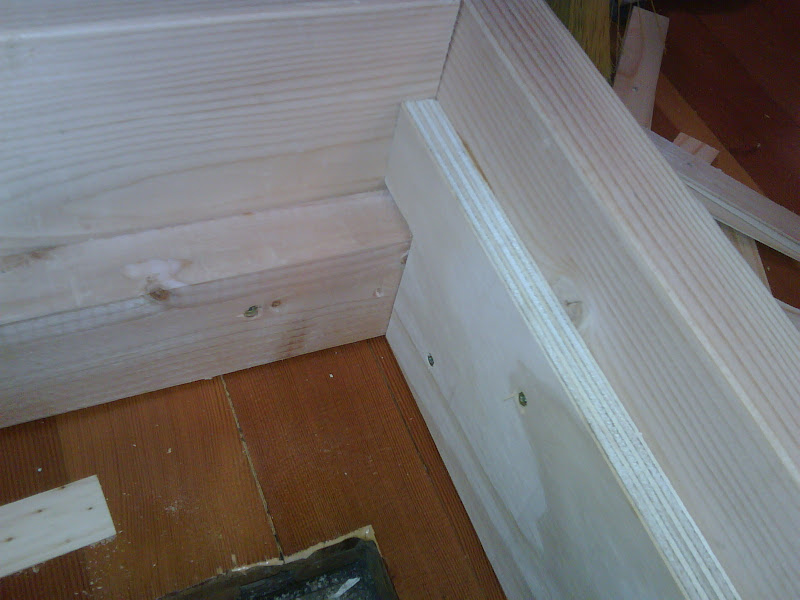
More of the plywood along the long span of the base:
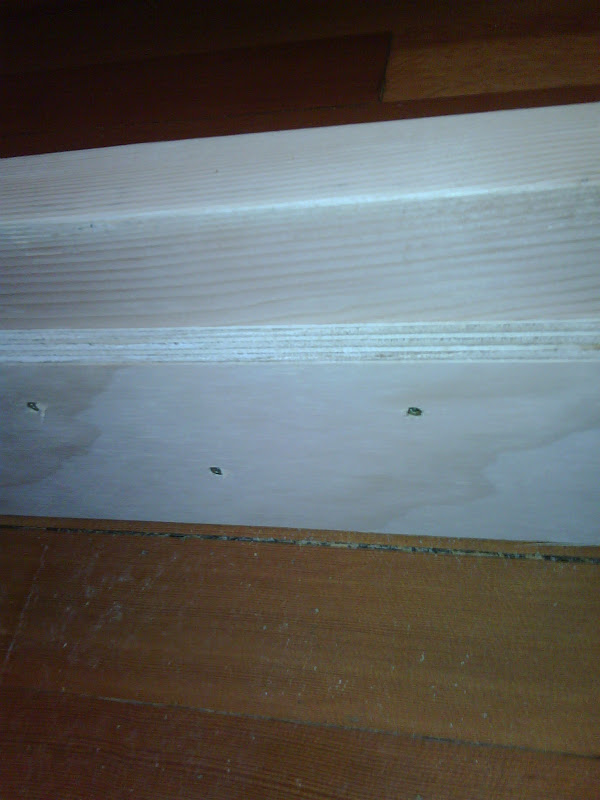
One of the challenges we faced is that our tank is going to be placed right over a cold air return for our heating/cooling system. So we had to put a vent onto the 2x8 span of our base. We made an arch instead of cutting a square. An arch has slightly less area than a square but is much stronger since it transfers the weight better.
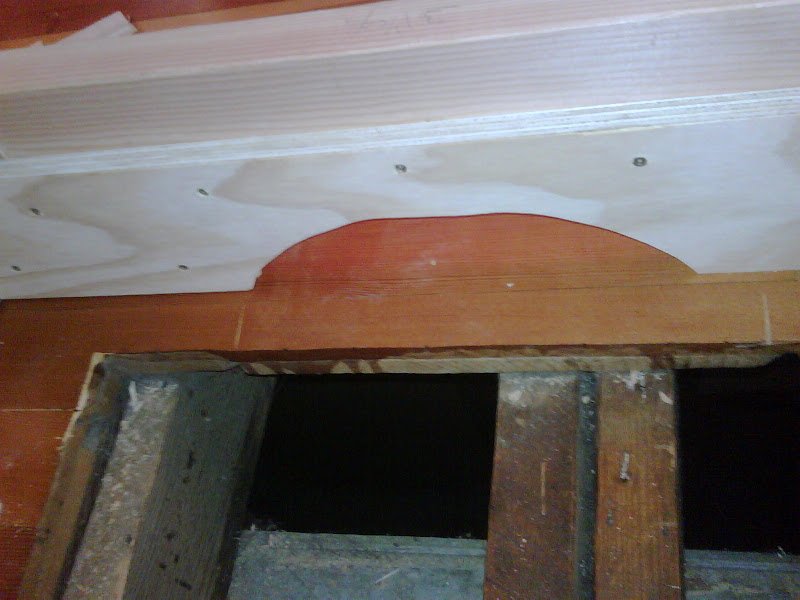
Since I am building cabinets below my tank we need to have a pretty wide span between our vertical supports. Who wants to have a ton of narrow drawers to work in lots of vertical supports? At the same time we wanted our vertical supports to be as narrow as possible. So we have to be sure that our vertical supports are very strong. We accomplished this by sandwitching 2x4's between two pieces of 3/4 in 7-ply birch plywood. This setup is very similar to the engineered I-beams used in modern home construction. This combo makes for an incredibly strong vertical support. The 2x4's rest directly upon the 2x8's of our base.

A closer look of our vertical support
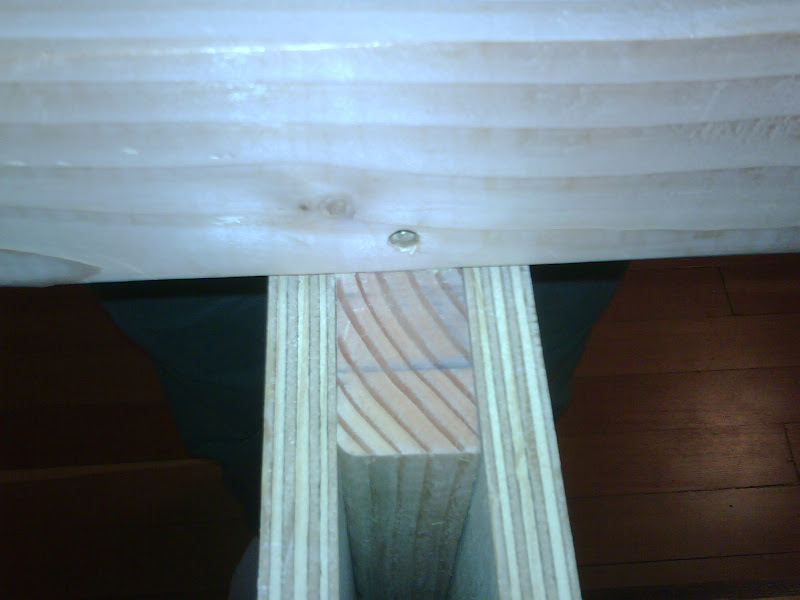
Next comes of support for the bottom of the tank. All of these precut pieces can make for quite a puzzle.
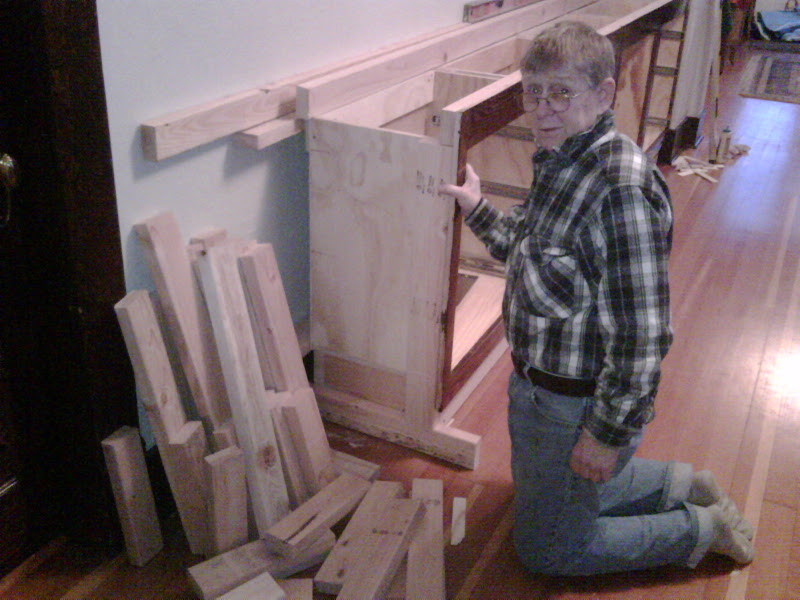
The frame for the bottom of the tank is 2x4's. The plywood will be screwed and glued to them.

Now we have a place for our tools until we get the tank module started. Stay tuned for the tank construction. We are currently finishing our cabinet drawers and doors.
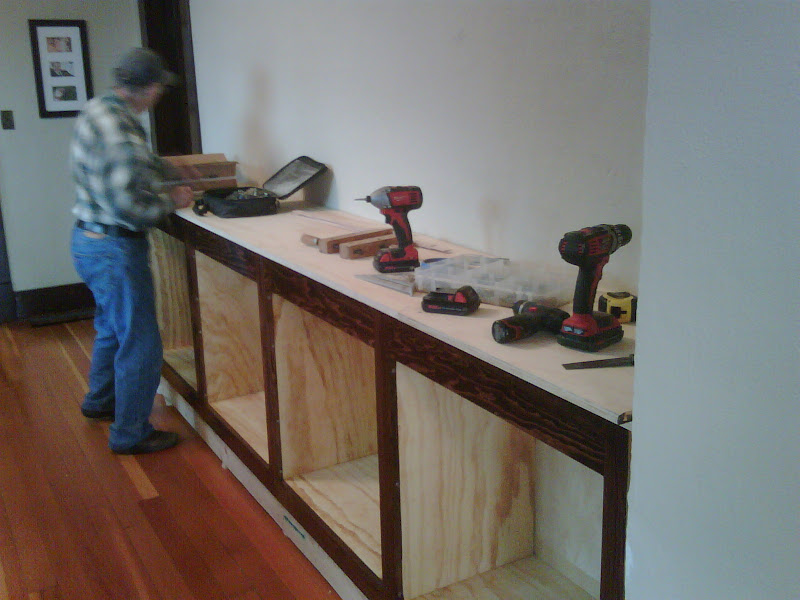
The base of a tank stand (or cabinet in my case) plays the important role of distributing the weight of the tank over the floor. It is critical that the base be strong enought that it doesnt sag any under the weight of the tanks water. My tank is just under 11 feet long and will hold almost approx 2500 pounds of water. So that is alot of weight over a long span. To make a very strong span we attached a 5 in tall piece of 3/4 in plywood to our 2x8 base board. The plywood is "glued and screwed" to the 2x8. This combination is stronger than two 2x8's screwed together. In addition, we braced the end 2x8 pieces with a 2x4. We didnt use plywood since the span is only about 18 inces.
A full shot of our completed base:

Here is the corner of our base. The corners of a base need to be really strong at they will receive stress on two planes instead of just one.

More of the plywood along the long span of the base:

One of the challenges we faced is that our tank is going to be placed right over a cold air return for our heating/cooling system. So we had to put a vent onto the 2x8 span of our base. We made an arch instead of cutting a square. An arch has slightly less area than a square but is much stronger since it transfers the weight better.

Since I am building cabinets below my tank we need to have a pretty wide span between our vertical supports. Who wants to have a ton of narrow drawers to work in lots of vertical supports? At the same time we wanted our vertical supports to be as narrow as possible. So we have to be sure that our vertical supports are very strong. We accomplished this by sandwitching 2x4's between two pieces of 3/4 in 7-ply birch plywood. This setup is very similar to the engineered I-beams used in modern home construction. This combo makes for an incredibly strong vertical support. The 2x4's rest directly upon the 2x8's of our base.

A closer look of our vertical support

Next comes of support for the bottom of the tank. All of these precut pieces can make for quite a puzzle.

The frame for the bottom of the tank is 2x4's. The plywood will be screwed and glued to them.

Now we have a place for our tools until we get the tank module started. Stay tuned for the tank construction. We are currently finishing our cabinet drawers and doors.

Looks great.
Umm... I feel kinda bad for asking but how much did a 120" piece of 3/4" glass cost?
And where in Oregon are you. I wanna see this thing when its done. I'll clean up my drool when I'm done staring I promise.
Umm... I feel kinda bad for asking but how much did a 120" piece of 3/4" glass cost?
And where in Oregon are you. I wanna see this thing when its done. I'll clean up my drool when I'm done staring I promise.
Well hopefully you didn't order yet. Let me put my two cents in here and you can then make the choice for yourself. If you look at mass produced aquariums with bracing you'll find that nearly all of them fall around 2 to 2.4 on the safety factor scale. The calculators work by calculating a rimless environment. If you look at your tank with those things in mind you'll find that a piece of 5/8's glass has a 2.4 safety factor with your dimensions.
The reason glass safety factors go up with length as well as depth is because of the stress being focused on the weakest point. In the case of a rimless aquarium that will be the middle of the pane from left to right. The deeper the aquarium the greater the pressure, the longer the pane the greater the focused pressure on the weak link. this is why bracing is used. It provides a support to this weak point, essentially dividing the pressure between 2 smaller panes, the section to the left and right of the brace. The pressure is not negated however thus the safety factor calculation cannot be divided in half. Water depth is now the most important factor. At this point let me state that overkill never hurts when building an aquarium when it comes to safety. However, overkill kills the pocketbook. IMHO you can use 5/8's glass with a rimless safety rating of 2.4 and be just fine.
The reason glass safety factors go up with length as well as depth is because of the stress being focused on the weakest point. In the case of a rimless aquarium that will be the middle of the pane from left to right. The deeper the aquarium the greater the pressure, the longer the pane the greater the focused pressure on the weak link. this is why bracing is used. It provides a support to this weak point, essentially dividing the pressure between 2 smaller panes, the section to the left and right of the brace. The pressure is not negated however thus the safety factor calculation cannot be divided in half. Water depth is now the most important factor. At this point let me state that overkill never hurts when building an aquarium when it comes to safety. However, overkill kills the pocketbook. IMHO you can use 5/8's glass with a rimless safety rating of 2.4 and be just fine.
Muni;3761389; said:Looks great.
Umm... I feel kinda bad for asking but how much did a 120" piece of 3/4" glass cost?
And where in Oregon are you. I wanna see this thing when its done. I'll clean up my drool when I'm done staring I promise.
Not sure on the glass yet. My glass guy is going to get back to me Monday. he had to check into prices for Starfire glass.
I live in The Dalles. You're very welcome to come and see the tank when I get it done. It will probably be two or so months before I have the entire tank and cabinet done as I am doing this in my spare time.
I meet with the PermaDri product rep tomorrow to get a lesson in using the sealant and fabric.
BTW- I have learned ALOT from following your build. Nice work!
Rivermud;3761877; said:Well hopefully you didn't order yet. Let me put my two cents in here and you can then make the choice for yourself. If you look at mass produced aquariums with bracing you'll find that nearly all of them fall around 2 to 2.4 on the safety factor scale. The calculators work by calculating a rimless environment. If you look at your tank with those things in mind you'll find that a piece of 5/8's glass has a 2.4 safety factor with your dimensions.
The reason glass safety factors go up with length as well as depth is because of the stress being focused on the weakest point. In the case of a rimless aquarium that will be the middle of the pane from left to right. The deeper the aquarium the greater the pressure, the longer the pane the greater the focused pressure on the weak link. this is why bracing is used. It provides a support to this weak point, essentially dividing the pressure between 2 smaller panes, the section to the left and right of the brace. The pressure is not negated however thus the safety factor calculation cannot be divided in half. Water depth is now the most important factor. At this point let me state that overkill never hurts when building an aquarium when it comes to safety. However, overkill kills the pocketbook. IMHO you can use 5/8's glass with a rimless safety rating of 2.4 and be just fine.
Rivermud- Thank you so much for your insight. Luckily I have not ordered that glass as my glass guy has to check into pricing for Starfire glass. I really appreciate your input. I was truly at a loss as to what glass thickness to go with given that the calculators were for rimless. My glass guy is going to get back to me with pricing for both 3/4 and 5/8. I will make the call then as to what piece to go with after a pocket book vs cracked glass analysis.
Cheers!
So we have began work on the tank itself and I will be posting pics soon.
However, we need to start planning the hood so I can get materials for it.
I contacted the guys at fishneedit.com because I liked the prices on their lights and the reviews on MFK were generally positive for them. They said that I should consider getting 3x of the 250w metal halides or 2x of their T5 + metal halide combo (seen here ) since the tank is so deep. But I wanted to see what other folks think.
I know that there is going to be a TON of heat generated so we are planning to have a fan venting the hood. In fact I will probably put the fan on a thermostatic switch. In addition, I will have a thermostatic switch for the lights that will turn them off if the temp in the hood gets to dangerous levels.
Oh, I would like to plant med to high light requirement plants.

However, we need to start planning the hood so I can get materials for it.
I contacted the guys at fishneedit.com because I liked the prices on their lights and the reviews on MFK were generally positive for them. They said that I should consider getting 3x of the 250w metal halides or 2x of their T5 + metal halide combo (seen here ) since the tank is so deep. But I wanted to see what other folks think.
I know that there is going to be a TON of heat generated so we are planning to have a fan venting the hood. In fact I will probably put the fan on a thermostatic switch. In addition, I will have a thermostatic switch for the lights that will turn them off if the temp in the hood gets to dangerous levels.
Oh, I would like to plant med to high light requirement plants.



